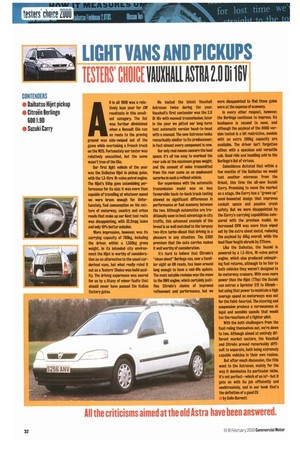LIGHT VANS AND PICKUPS
Page 34

If you've noticed an error in this article please click here to report it so we can fix it.
TESTERS' CHOICE HUME ASTRA 2.0 Di 1811
Al in all 1999 was a relatively lean year for CM roadtests in this smallest category. The list was further diminished when a Renault CIM van en route to the proving ground was side-swiped out of the game while overtaking a French truck on the M25. Fortunately our tester was relatively unscathed, but the same wasn't true of the Clio.
Our first light vehicle of the year was the Daihatsu Bidet in pickup guise, with the t3-litre 16-valve petrol engine. The Hiiet's 64hp gave astonishing performance for its size: it was more than capable of travelling at whatever speed we were brave enough for. Unfortunately, fuel consumption on the mixture of motorway, country and urban roads that make up our Kent test route was disappointing. with 32.2mpg laden and only 100,0 better unladen.
More impressive, however, was its carrying capacity of 760kg, including the driver, within a 1,550kg gross weight. In its intended city environment the Hijet is worthy of consideration as an alternative to the usual carderived vans, but what really ruled it out as a Testers Choice was build quality. The driving experience was soured for us by a litany of minor faults that should never have passed the Italian factory gates. We tested the latest Vauxhall Astravan twice during the year. Vauxhall's first contender was the 2.0 Di 16v with manual transmission; later in the year we pitted our long-term test automatic version head-to-head with a manual. The new Astravan looks remarkably similar to its predecessor; in fact almost every component is new.
Our only real moans concern the load space: it's all too easy to overload the rear axle at the maximum gross weight; and the amount of noise transmitted from the rear came as an unpleasant surprise in such a refined vehicle.
Our experience with the automatic transmission model was no less favourable: back-to-back track testing showed no significant differences in performance or fuel economy between the two. Although automatics are traditionally seen to best advantage in city traffic, this advanced example of the breed is so well matched to the torquey two-litre turbo-diesel that driving is a pleasure in any situation. The £800 premium that the auto carries makes it well worthy of consideration.
It's hard to believe that Citroen's ''clean sheet' Berlingo van, now a familiar sight on UK roads, has been around long enough to have a mid-life update. The most notable revision was the move to the 0W8 engine, which certainly justifies Citroen's claims of improved refinement and performance, but we were disappointed to find these gains were at the expense of economy.
In every other respect, however. the Berlingo continues to impress. Its loadspace is second to none, and although the payload of the 6000 version tested is a bit restrictive, models with an extra 200kg capacity are available. The driver isn't forgotten either, with a spacious and versatile cab. Good ride and handling add to the Berlingo's list of virtues.
Coincidence dictated that within a few months of the Daihatsu we would test another microvan from the Orient, this time the all-new Suzuki Carry. Promising to move the market on a stage, the Carry has a "grown up" semi-bonneted design that improves cockpit space and passive crash safety. But we were disappointed by the Carry's carrying capabilities compared with the previous model. An increased GVW was more than wiped out by the extra sheet metal. reducing the payload by 48kg overall, while the load floor length shrunk by 270mm.
Like the Daihatsu. the Suzuki is powered by a 1.3-litre, 16-valve petrol engine, which also produced uninspiring fuel returns, although to be fair to both vehicles they weren't designed to be motorway cruisers. With even more power than the Hijet (77hp) the Suzuki can outrun a Sprinter 312 to 50mphbut using that power to maintain a high average speed on motorways was not for the faint-hearted. The steering and suspension produce a nervousness at legal and sensible speeds that would tax the reactions of a fighter pilot.
With the both challengers from the East ruling themselves out, we're down to two. Although aimed at entirely different market sectors. the Vauxhall and Citroen proved remarkably difficult to separate, both being extremely capable vehicles in their own realms.
But after much discussion, the title went to the Astravan, mainly for the way it dominates its particular niche. Its not perfect—which of us is?—but it gets on with its job efficiently and unobtrusively, and in our book that's the definition of a good CV.
by Cohn Barnett












































































































